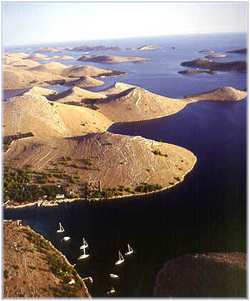


Accommodation
online
|
Island Kaprije
KAPRIJE, an island in the central part of the Sibenik archipelago, between the islands of Zmajan and Kakan, separated from them by the Zmajan and Kakan channels; area 6.97 sq km; population 130. The highest peak of the island is Vela Glavica (132 m). Larger coves are Jelinjaca, Gacice and Vanjska. There are no surface water streams on the island, which is generally covered with grasses and low underbrush. Smaller plots of arable land may be found in valleys, which also comprise olive-groves and vineyards. Chief occupations are farming, viticulture, olive growing, fishing and tourism. The only settlement, Kaprije, lies on the south-western coast of the island. The hamlet of Medos on the north-eastern coast is occasionally populated by the inhabitants of Murter who have their lands there. In the 19th century the island was owned by the aristocratic family Ljubic from Sibenik and from 1500 by the aristocratic family Divnic (Difinico). The first settlers on the island were mentioned in the 15th century. From 1510 Kaprije was the shelter of the refugees from the mainland, who fled from the Turks. The church in Kaprije dates back to the 16th-17th century (extended in 1801).
North side of Island Kaprije (view to Vodice)........
Kaprije from air Island Zirije
...... National Park Kornati Archipelago
Beauty and singularity of the archipelago moved authorities in 1980 to proclaim a bigger part of that area national park. Since then certain modifications of its borders were made, so that nowadays Kornati National Park occupies the area of about 220 km2 (54.000 acres). There are 89 islands, islets and reefs within the area of Kornati National Park (185 km of the coastline), what makes it the most indented group of islands in the Mediterranean. The land part of Kornati National Park covers less than 1/4 of its total area, but the values of its landscapes, the "crowns" (cliffs) on the islands facing the open sea, and interesting relief structures, make this part of Kornati National Park unique. Besides, the Kornati submarine area, whose biocenosis are considered to be the richest in the Adriatic Sea, and also the magnificent geomorphology of the sea bed attracts divers from all over Europe to come and enjoy in unforgettable submarine adventures.
|
Copyright
www.darkec.com









 Which
includes a bigger part of Kornati archipelago,
Which
includes a bigger part of Kornati archipelago, 








